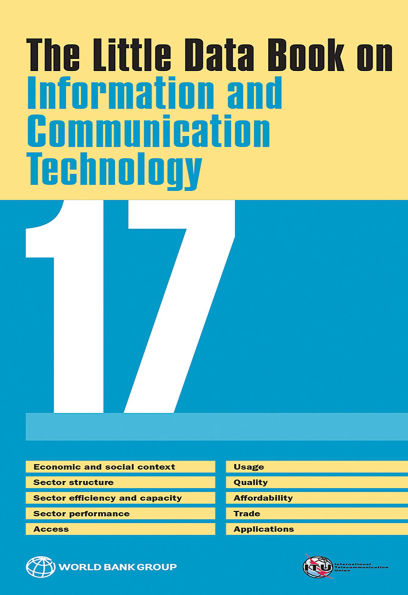The Little Data Book on Information and Communication Technology 2017
Since the late 1990s access to information and communication technologies (ICTs) has seen tremendous growth-driven primarily by the wireless technologies and liberalization of telecommunications markets. Mobile communications have evolved from simple voice and text services to diversified innovative applications and mobile broadband Internet. In 2016, there were more than 7.3 billion mobile-cellular subscriptions worldwide. Globally, 3.5 billion people were using the Internet, of which 2.5 billion were from developing countries. Mobile-broadband subscriptions have risen constantly to reach 3.6 billion, while the number of fixed-broadband subscriptions reached more than 884 million during the same period. The impacts of ICTs cross all sectors. Research has shown that investment in information and communication technoslogies is associated with sucheconomic benefits as higher productivity, lower costs, new economic opportunities, job creation, innovation, and increased trade. ICTS also help provide better services in health and education, and strengthen social cohesion. The Little Data Book on Information and Communication Technology 2017 Illustrates the progress of this revolution for 217 economies around the world. It provides comparable statistics on the sector for 2005 and 2015 across a range of indicators, enabling readers to readily compare economies. This book includes indicators covering the economic and social context, the structure of the information and communication technology sector, sector efficiency and capacity, and sector performance related to access, usage, quality, affordability, trade, and applications. The glossary contains definitions of the terms used in the tables.
1125812540
The Little Data Book on Information and Communication Technology 2017
Since the late 1990s access to information and communication technologies (ICTs) has seen tremendous growth-driven primarily by the wireless technologies and liberalization of telecommunications markets. Mobile communications have evolved from simple voice and text services to diversified innovative applications and mobile broadband Internet. In 2016, there were more than 7.3 billion mobile-cellular subscriptions worldwide. Globally, 3.5 billion people were using the Internet, of which 2.5 billion were from developing countries. Mobile-broadband subscriptions have risen constantly to reach 3.6 billion, while the number of fixed-broadband subscriptions reached more than 884 million during the same period. The impacts of ICTs cross all sectors. Research has shown that investment in information and communication technoslogies is associated with sucheconomic benefits as higher productivity, lower costs, new economic opportunities, job creation, innovation, and increased trade. ICTS also help provide better services in health and education, and strengthen social cohesion. The Little Data Book on Information and Communication Technology 2017 Illustrates the progress of this revolution for 217 economies around the world. It provides comparable statistics on the sector for 2005 and 2015 across a range of indicators, enabling readers to readily compare economies. This book includes indicators covering the economic and social context, the structure of the information and communication technology sector, sector efficiency and capacity, and sector performance related to access, usage, quality, affordability, trade, and applications. The glossary contains definitions of the terms used in the tables.
14.99
In Stock
5
1

The Little Data Book on Information and Communication Technology 2017
246
The Little Data Book on Information and Communication Technology 2017
246
14.99
In Stock

Product Details
| ISBN-13: | 9781464810299 |
|---|---|
| Publisher: | World Bank Publications |
| Publication date: | 01/09/2017 |
| Series: | World Development Indicators |
| Sold by: | INDEPENDENT PUB GROUP - EPUB - EBKS |
| Format: | eBook |
| Pages: | 246 |
| File size: | 2 MB |
From the B&N Reads Blog
